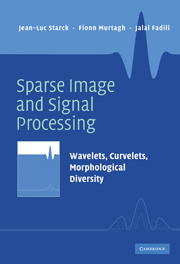Book contents
- Frontmatter
- Contents
- Acronyms
- Notation
- Preface
- 1 Introduction to the World of Sparsity
- 2 The Wavelet Transform
- 3 Redundant Wavelet Transform
- 4 Nonlinear Multiscale Transforms
- 5 The Ridgelet and Curvelet Transforms
- 6 Sparsity and Noise Removal
- 7 Linear Inverse Problems
- 8 Morphological Diversity
- 9 Sparse Blind Source Separation
- 10 Multiscale Geometric Analysis on the Sphere
- 11 Compressed Sensing
- References
- List of Algorithms
- Index
- Plate section
1 - Introduction to the World of Sparsity
Published online by Cambridge University Press: 06 July 2010
- Frontmatter
- Contents
- Acronyms
- Notation
- Preface
- 1 Introduction to the World of Sparsity
- 2 The Wavelet Transform
- 3 Redundant Wavelet Transform
- 4 Nonlinear Multiscale Transforms
- 5 The Ridgelet and Curvelet Transforms
- 6 Sparsity and Noise Removal
- 7 Linear Inverse Problems
- 8 Morphological Diversity
- 9 Sparse Blind Source Separation
- 10 Multiscale Geometric Analysis on the Sphere
- 11 Compressed Sensing
- References
- List of Algorithms
- Index
- Plate section
Summary
We first explore recent developments in multiresolution analysis. Essential terminology is introduced in the scope of our general overview, which includes the coverage of sparsity and sampling, best dictionaries, overcomplete representation and redundancy, compressed sensing and sparse representation, and morphological diversity.
Then we describe a range of applications of visualization, filtering, feature detection, and image grading. Applications range over Earth observation and astronomy, medicine, civil engineering and materials science, and image databases generally.
SPARSE REPRESENTATION
Introduction
In the last decade, sparsity has emerged as one of the leading concepts in a wide range of signal-processing applications (restoration, feature extraction, source separation, and compression, to name only a few applications). Sparsity has long been an attractive theoretical and practical signal property in many areas of applied mathematics (such as computational harmonic analysis, statistical estimation, and theoretical signal processing).
Recently, researchers spanning a wide range of viewpoints have advocated the use of overcomplete signal representations. Such representations differ from the more traditional representations because they offer a wider range of generating elements (called atoms). Indeed, the attractiveness of redundant signal representations relies on their ability to economically (or compactly) represent a large class of signals. Potentially, this wider range allows more flexibility in signal representation and adaptivity to its morphological content and entails more effectiveness in many signal-processing tasks (restoration, separation, compression, and estimation). Neuroscience also underlined the role of overcompleteness.
Information
- Type
- Chapter
- Information
- Sparse Image and Signal ProcessingWavelets, Curvelets, Morphological Diversity, pp. 1 - 15Publisher: Cambridge University PressPrint publication year: 2010
